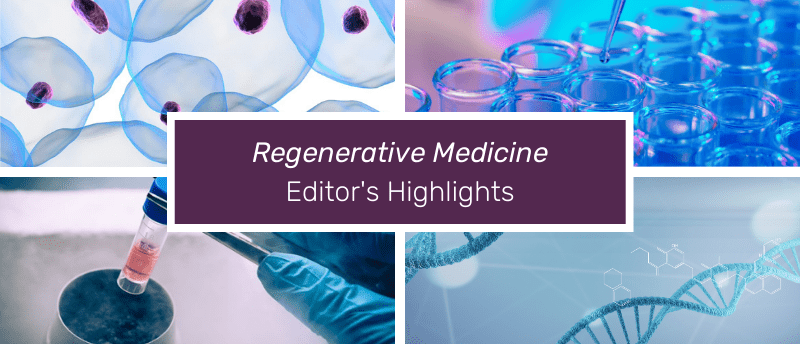Regenerative Medicine Highlights: January – March 2023

Journal Development Editor, Jasmine Hagan, shares her top papers from the January, February and March issues of Regenerative Medicine.
2023 has rolled off to a great start for Regenerative Medicine as we have continued to publish papers covering an array of topics in the field, including the use of exosomes in regenerative aesthetics, mesenchymal stem cell therapy and policies relating to stem cell-based embryo models.
In this feature, I share some of my top articles from the first three issues of Volume 18, providing a snapshot of some of the most exciting work in the field published in Regenerative Medicine.
The two-bucket problem of unproven stem cell interventions
With unproven stem cell interventions being an increasingly discussed topic in the field of regenerative medicine, this editorial seeks to challenge the current dogma about unproven stem cell interventions. The author raises some very interesting points in the article, particularly highlighting the need to move away from conversations around the classification of these interventions and to start addressing other concerns, such as how the problem can be solved and how misinformation surrounding these interventions can influence patients’ behavior. Perhaps this editorial will encourage an open conversation among researchers, practitioners and patients to address these issues and promote progress in the field.
How can adult zebrafish and neonatal mice teach us about stimulating cardiac regeneration in the human heart?
Drawing inspiration from the cardiac regenerative potential of zebrafish and neonatal mice, the authors of this article explore how the translation of these regenerative mechanisms can be utilized to develop novel therapies for cardiovascular diseases. The review provides insight into the mechanism behind the regeneration of cardiomyocytes to replace damaged myocardium in zebrafish and neonatal mice. The authors discuss the role of factors such as NRG1, IL-10 and c-MYc that promote cardiomyocyte proliferation and cardiac regeneration. While further studies exploring cardiac regeneration are required, this review suggests that there might be a new potential therapeutic avenue for repairing damaged cardiac tissue in humans.
Current knowledge and future perspectives on exosomes in the field of regenerative medicine: a bibliometric analysis
With exosomes remaining a research topic of great interest, this article provides an overview of the applications of exosomes in regenerative medicine. A bibliometric analysis was conducted to identify research hotspots and emerging trends in the field. The authors identified China as a major contributor to research on exosomes, followed by the USA and Italy. Additionally, the institution with the highest number of published and cited articles on the topic was identified as Shanghai Jiao Tong University (Shanghai, China). Research hotspots included exosome-mediated cartilage regeneration and repair, exosome-mediated neurovascular regeneration and exosome-mediated cardiac regeneration. As researchers seek to find cell-free therapeutic candidates, the authors anticipate that interest in exosomes will continue to grow.
International evaluation study of a highly efficient culture assay for detection of residual human pluripotent stem cells in cell therapies
Human pluripotent stem cells (hPSCs) have become a promising cell source for cell therapy products. One challenge that has emerged in the production of hPSC-derived cell therapy products is the risk of contamination with undifferentiated hPSCs that are tumorigenic and can form teratomas. In this article, the researchers seek to address this issue by highlighting the need for rigorous assessment of hPSC-derived cell therapy products. An international collaborative effort evaluated the feasibility of the in vitro testing method – a highly efficient culture assay for the detection of residual undifferentiated hPSCs. The findings of the study showed that, with a standardized protocol, all the facilities involved in the study detected colonies of undifferentiated hPSCs. The researchers confirmed that this method can be utilized to evaluate the tumorigenicity of hPSC–derived cell therapy products.
Don’t forget to check out the rest of the articles from the January, February and March issues of Volume 18.
Be sure to get in touch if you have any queries about Regenerative Medicine or are interested in publishing in the journal, please contact Journal Development Editor, Jasmine Hagan ([email protected]).